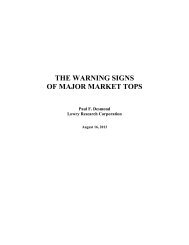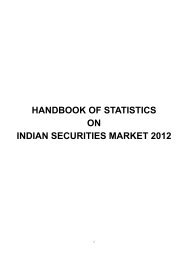1 |
april2016
april2016
Create successful ePaper yourself
Turn your PDF publications into a flip-book with our unique Google optimized e-Paper software.
PERFORMANCE BOOSTING: ENHANCING THE<br />
PROFITABILITY OF QUANTITATIVE INVESTING<br />
STRATEGIES<br />
Editor’s note: this was originally posted at HoodRiverResearch.com and is reprinted here to introduce readers to the<br />
philosophy of David Aronson who will be a presenter at the MTA’s Annual Symposium.<br />
There is a need for quantitative strategies to differentiate themselves from competitors and to maximize returns. There<br />
are two approaches to doing this:<br />
1. Improving execution algorithms to minimize the price impact of strategy buy and sell orders, or<br />
2. Increasing the returns that can be earned from the strategy’s buy and sell signals.<br />
Hood River Research (HRR) favors taking the second approach. The return of your strategy is increased by predicting which<br />
signals are likely to be the most and least profitable, thereby allowing you to take larger positions on signals with the<br />
highest expectations and smaller positions on those with the lowest expected returns. The predictions are based on<br />
indicators that quantify the trading dynamics of a security at the time your strategy issues a signal to initiate a position.<br />
Hood River’s process relies on sophisticated data preprocessing and an ensemble of non-parametric modeling techniques<br />
designed to uncover patterns invisible to less powerful modeling methods.<br />
The deliverable is a performance boosting model, which is a second-stage prediction model, designed to work in<br />
conjunction with your existing strategy. Past projects have shown that signals predicted to generate the highest returns<br />
produce gains that are 1.5 to 3 times larger than average signal returns while signal predicted to perform poorly can have<br />
negative expected returns.<br />
The Benefit of Performance Boosting: More Knowledge<br />
To clarify the knowledge conferred by the second-stage model, consider the knowledge possessed by the investor not<br />
using one. Suppose this investor employs a low-PE strategy. Each month all stocks in the investor’s universe are broken<br />
into deciles based on their PE ratio. A typical strategy would be to buy the stocks in the lowest PE decile (decile 1). Assume<br />
that a historical back-test of the strategy has shown that stocks in the lowest PE decile produce an excess return versus<br />
the universe of 0.50% over the one-month period following purchase. From this investor’s state of knowledge, all that can<br />
be said each time the low-PE strategy signals the purchase of a security is that it has an expected one-month excess return<br />
APRIL 2016<br />
16 | TECHNICALLY SPEAKING




